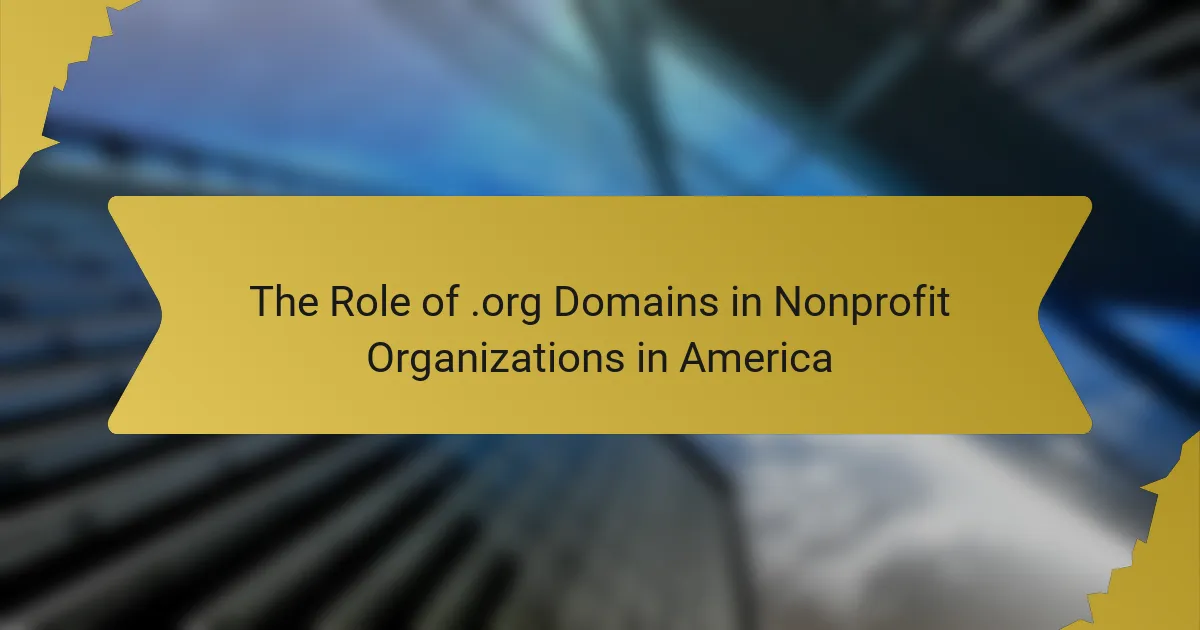.org domains play a crucial role for nonprofit organizations in America by enhancing their credibility and fostering trust with donors. Recognized as the standard for charitable entities, these domains improve visibility in search engines and help nonprofits effectively communicate their mission to potential supporters.
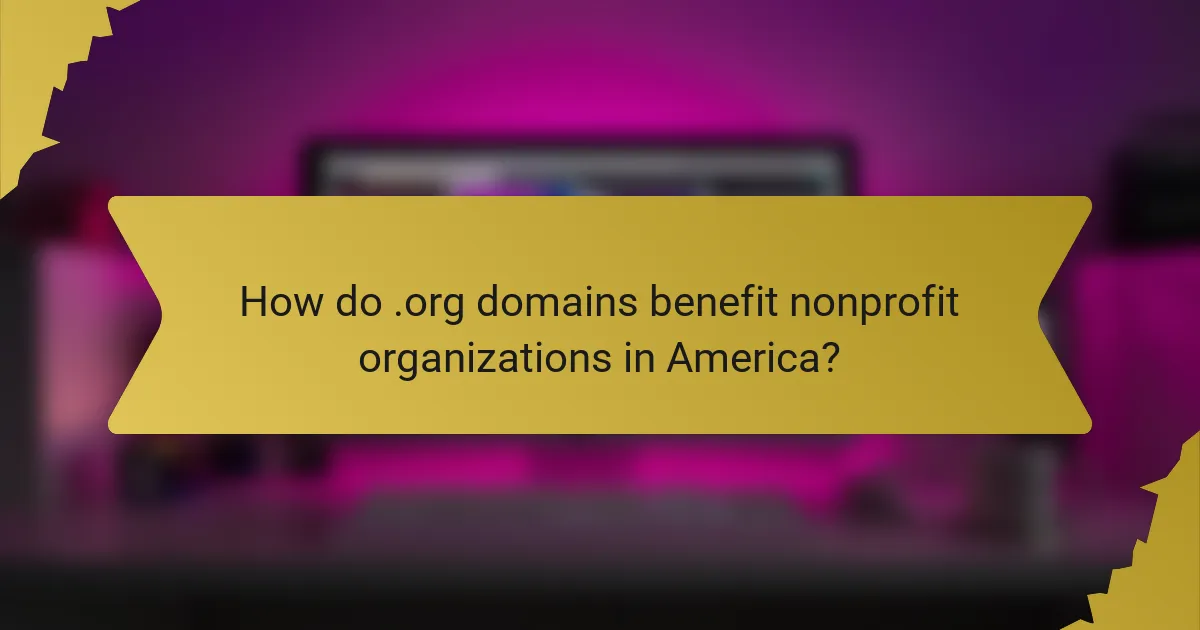
How do .org domains benefit nonprofit organizations in America?
.org domains provide significant advantages for nonprofit organizations in America by enhancing their credibility, fostering trust with donors, and improving their visibility in search engines. These benefits help nonprofits establish a strong online presence and effectively communicate their mission to potential supporters.
Enhanced credibility
Having a .org domain instantly signals to visitors that an organization is a nonprofit entity. This domain extension is widely recognized and associated with charitable work, which can enhance the organization’s overall credibility. Nonprofits using .org domains are often perceived as more legitimate compared to those using commercial domains like .com.
For example, a nonprofit focused on environmental conservation with a website ending in .org may attract more visitors and supporters than a similar organization using a .net or .info domain. This perception can lead to increased engagement and support from the community.
Increased trust from donors
Donors are more likely to contribute to organizations that they trust. A .org domain can help build that trust, as it indicates a commitment to a social cause rather than profit. Nonprofits with .org domains often find that potential donors feel more secure in their decision to support the organization.
To further enhance trust, nonprofits should ensure their websites are professional, user-friendly, and transparent about their operations and financials. Regular updates on projects and clear communication about how donations are used can also strengthen donor confidence.
Improved search visibility
Search engines often prioritize .org domains in search results related to nonprofit activities. This can lead to improved visibility for organizations, making it easier for potential supporters to find them online. By optimizing their websites with relevant keywords and quality content, nonprofits can leverage their .org domain to attract more traffic.
To maximize search visibility, nonprofits should focus on creating valuable content that addresses the interests of their audience. This includes blog posts, success stories, and informative resources related to their mission. Engaging with social media and building backlinks from reputable sites can also enhance their search rankings.
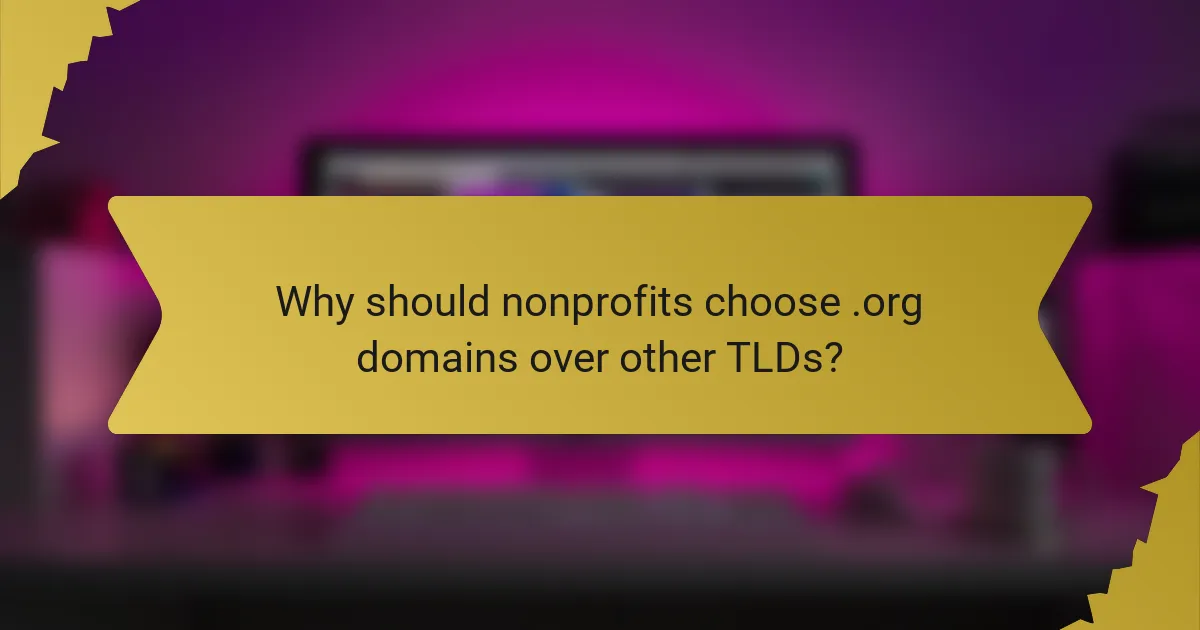
Why should nonprofits choose .org domains over other TLDs?
Nonprofits should choose .org domains because they are widely recognized as the standard for organizations with a charitable mission. This top-level domain (TLD) enhances credibility and trust among supporters and stakeholders.
Association with nonprofit status
The .org domain is inherently associated with nonprofit organizations, making it a natural choice for groups focused on social causes. This association signals to the public that the organization is dedicated to serving the community rather than generating profit.
Using a .org domain can help nonprofits differentiate themselves from for-profit entities, reinforcing their mission-driven identity. This distinction is crucial in fundraising and outreach efforts, as it aligns with the expectations of donors and volunteers.
Favorable perception among stakeholders
Organizations using .org domains may experience higher levels of support, as stakeholders often feel more confident contributing to entities that clearly identify as nonprofit. This can lead to increased donations and volunteer participation, essential for sustaining nonprofit operations.
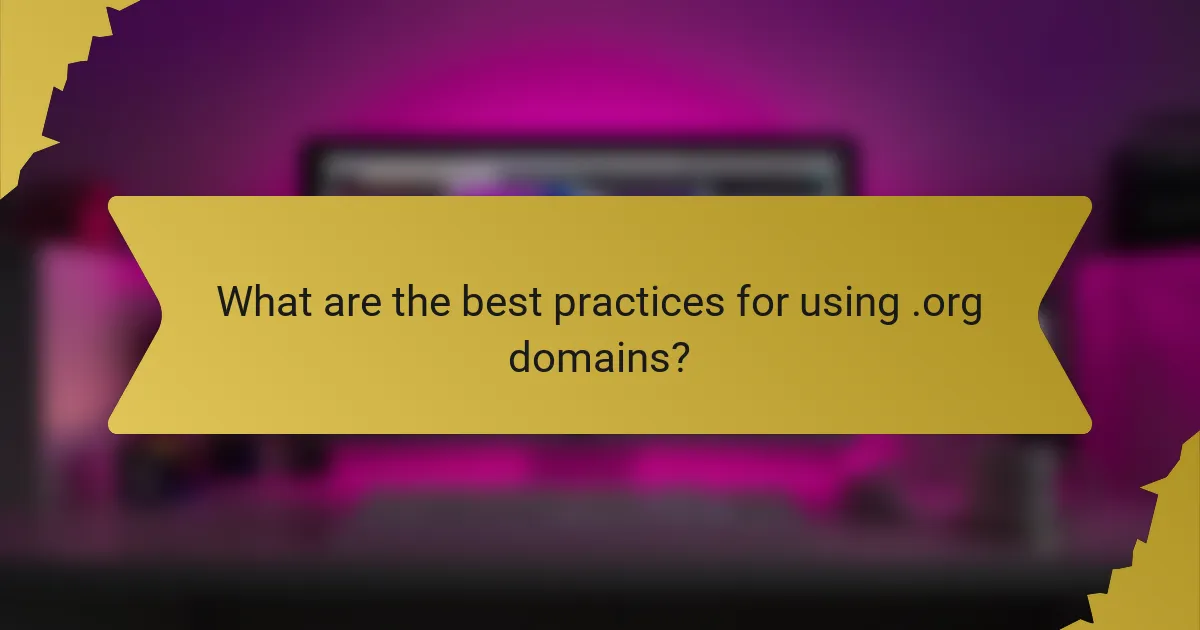
What are the best practices for using .org domains?
Best practices for using .org domains include maintaining consistent branding, optimizing for search engines, and ensuring user trust. These practices help nonprofit organizations effectively communicate their mission and enhance their online presence.
Consistent branding
Consistent branding is crucial for nonprofits using .org domains. This includes using the same logo, color scheme, and messaging across all platforms, which helps build recognition and trust with supporters. For example, a nonprofit should ensure that its website, social media profiles, and printed materials all reflect the same visual identity.
Additionally, nonprofits should choose a domain name that clearly represents their mission. A straightforward name that aligns with the organization’s purpose can enhance memorability and credibility. For instance, a wildlife conservation group might use a name like “SaveWildlife.org” to clearly convey its focus.
SEO optimization strategies
Search engine optimization (SEO) is vital for nonprofits to increase their visibility online. Nonprofits should focus on relevant keywords that potential supporters might use when searching for related causes. Incorporating these keywords naturally into website content, meta descriptions, and headers can improve search rankings.
Moreover, creating high-quality content that addresses the needs and interests of the target audience can enhance engagement. Regularly updating the website with blog posts, success stories, and event announcements can keep the content fresh and encourage return visits. Nonprofits should also consider building backlinks from reputable sites to further boost their SEO efforts.
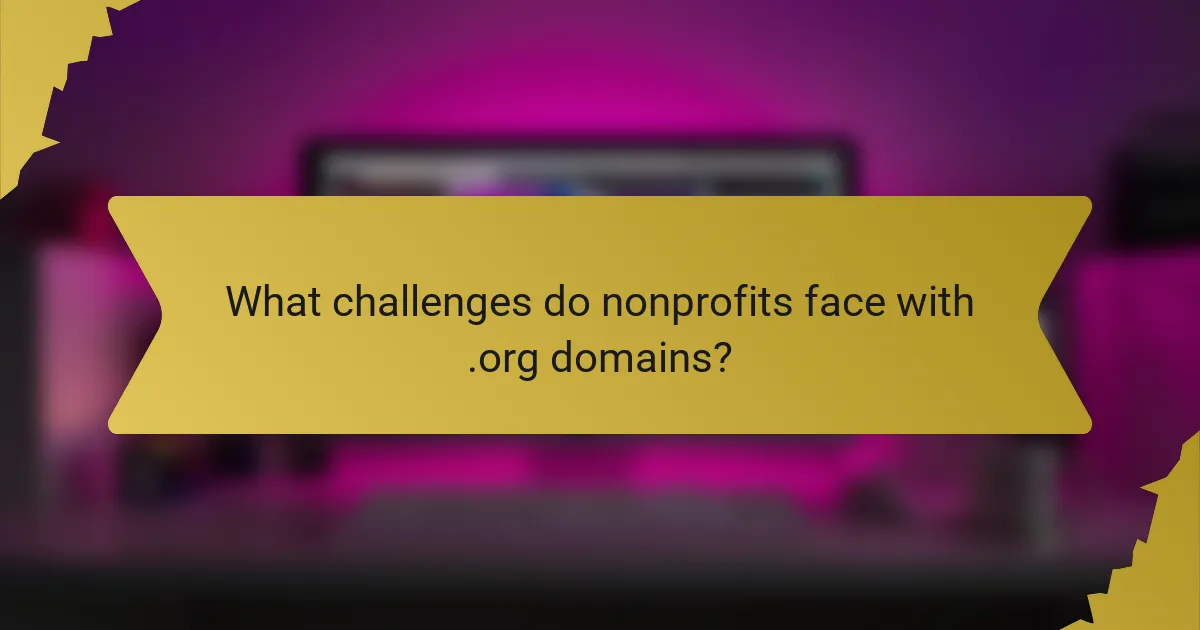
What challenges do nonprofits face with .org domains?
Nonprofits encounter several challenges with .org domains, including domain name availability and ongoing maintenance costs. These issues can impact their online presence and operational budgets, making it crucial for organizations to navigate them effectively.
Domain name availability
Finding an available .org domain can be difficult for nonprofits, especially as many desirable names are already taken. Organizations should consider variations or creative alternatives that still reflect their mission. Using keywords related to their cause can help in brainstorming unique domain names.
Additionally, nonprofits can explore purchasing existing domains from current owners. This option may require negotiation and a budget that accommodates potential higher costs, but it can provide a more recognizable online identity.
Maintenance costs
Maintaining a .org domain involves annual registration fees, which can vary widely based on the registrar and any additional services chosen. Nonprofits should budget for these costs, typically ranging from $10 to $50 per year, depending on the domain’s popularity and the features included.
Beyond registration, nonprofits may incur costs for web hosting, security certificates, and website maintenance. It’s advisable to evaluate these expenses regularly and consider bundled services that can offer savings while ensuring a professional online presence.

How can nonprofits effectively promote their .org domains?
Nonprofits can effectively promote their .org domains by leveraging various digital marketing strategies that enhance visibility and engagement. Key methods include utilizing social media platforms and implementing targeted email marketing campaigns to reach their audience.
Utilizing social media
Social media is a powerful tool for nonprofits to promote their .org domains and connect with supporters. By creating engaging content that highlights their mission and impact, organizations can drive traffic to their websites. Regularly posting updates, success stories, and calls to action can foster community and encourage sharing.
Nonprofits should consider using platforms like Facebook, Twitter, and Instagram to reach different demographics. Tailoring content for each platform can maximize engagement; for instance, visual stories work well on Instagram, while informative posts may be more effective on Facebook. Incorporating links to their .org domain in posts and bios is crucial for directing traffic.
Email marketing campaigns
Email marketing campaigns are an effective way for nonprofits to promote their .org domains directly to their supporters. By building a mailing list, organizations can send newsletters, updates, and fundraising appeals that include links to their website. This approach helps maintain engagement and encourages donations or volunteer sign-ups.
To optimize email campaigns, nonprofits should segment their audience based on interests or past interactions. Personalizing emails can increase open rates and engagement. Including clear calls to action and ensuring that the .org domain is prominently featured can drive traffic and enhance the organization’s online presence.

What are the legal considerations for .org domains?
.org domains are primarily intended for nonprofit organizations, and there are specific legal considerations associated with their registration and use. Organizations must ensure compliance with both domain registration requirements and nonprofit regulations to maintain their status and credibility.
Domain registration requirements
To register a .org domain, an organization must provide accurate information about its legal status and purpose. While there are no strict eligibility criteria, registrars typically expect applicants to be recognized as nonprofit entities, which may require documentation such as tax-exempt status under IRS regulations.
It’s advisable to choose a registrar that specializes in nonprofit domains, as they may offer additional services tailored to the needs of these organizations. Commonly, registration fees range from $10 to $50 per year, depending on the registrar and any additional services included.
Compliance with nonprofit regulations
Nonprofit organizations using .org domains must adhere to various federal and state regulations governing their operations. This includes maintaining transparency in financial reporting and ensuring that their activities align with their stated mission. Failure to comply can result in loss of tax-exempt status or legal penalties.
Organizations should regularly review their compliance with the IRS and state requirements, as these can vary significantly. It’s recommended to consult with legal experts familiar with nonprofit law to navigate these regulations effectively and avoid common pitfalls.
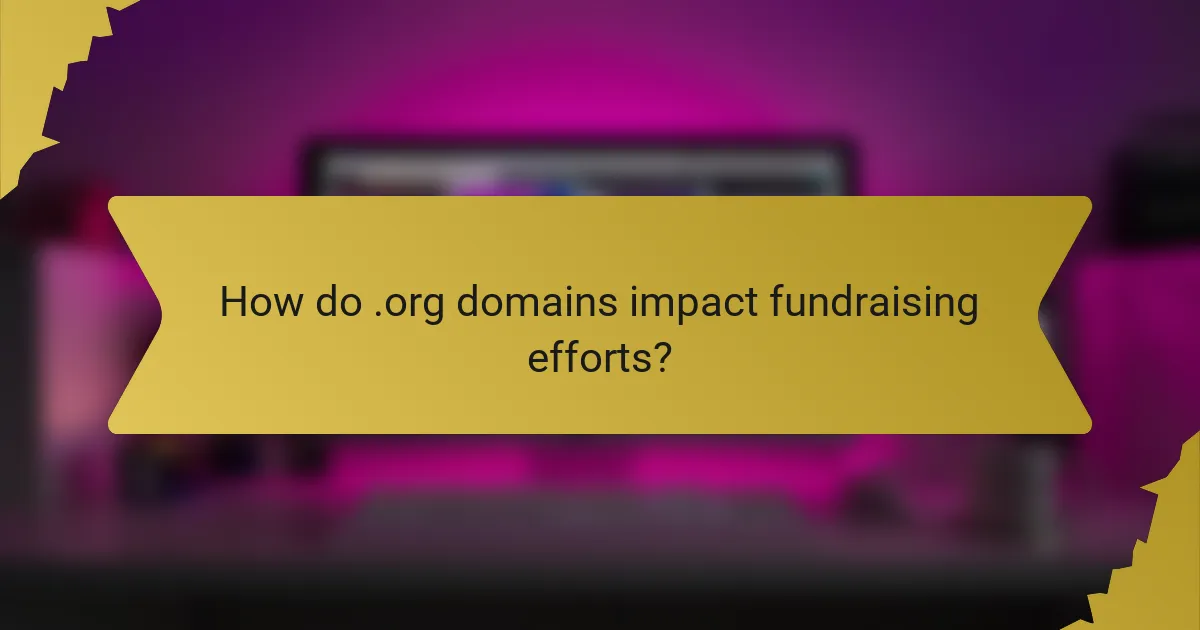
How do .org domains impact fundraising efforts?
.org domains significantly enhance fundraising efforts for nonprofit organizations by establishing credibility and trust with potential donors. These domains are recognized as a standard for nonprofits, which can lead to increased donations and engagement.
Increased donor engagement
Using a .org domain helps nonprofits connect more effectively with their audience, fostering a sense of community and trust. Donors are more likely to engage with organizations that have a dedicated online presence, as it signals legitimacy and commitment to their cause.
To maximize engagement, nonprofits should regularly update their websites with compelling stories, testimonials, and impact reports. This transparency can encourage donors to feel more connected and invested in the organization’s mission.
Facilitation of online donations
A .org domain can streamline the process of online donations, making it easier for supporters to contribute. Many donors prefer to give online, and a professional website with a .org domain can enhance the user experience, leading to higher conversion rates.
Nonprofits should ensure that their donation pages are user-friendly and secure, offering multiple payment options. Implementing features like recurring donations or matching gift programs can also encourage larger contributions and sustained support.
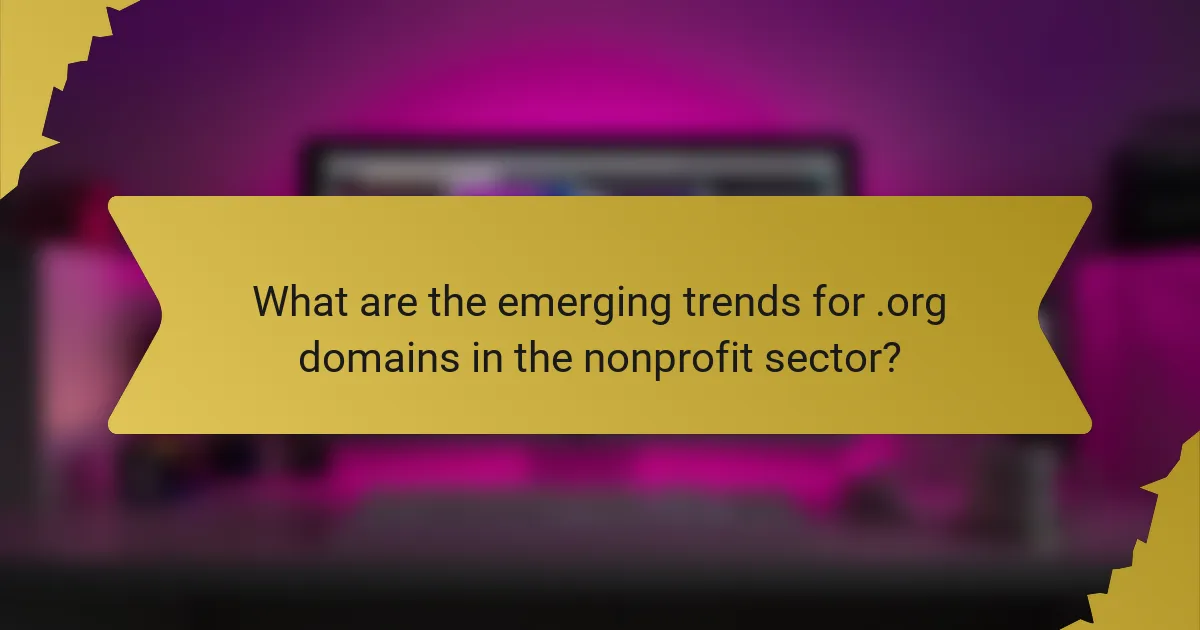
What are the emerging trends for .org domains in the nonprofit sector?
Emerging trends for .org domains in the nonprofit sector include increased demand for digital presence, a focus on transparency, and the rise of online fundraising. Nonprofits are leveraging .org domains to enhance credibility and connect with supporters more effectively.
Increased Demand for Digital Presence
As more organizations recognize the importance of online visibility, the demand for .org domains is rising. Nonprofits are establishing websites to share their missions, programs, and impact, making it essential to secure a .org domain to signify their nonprofit status.
Organizations are also optimizing their websites for mobile devices, ensuring accessibility for a broader audience. This trend reflects the growing reliance on digital platforms for information and engagement.
Focus on Transparency and Trust
Nonprofits are increasingly prioritizing transparency, and having a .org domain can enhance trust among potential donors and volunteers. A .org domain signals that an organization is dedicated to a social cause, which can attract more support.
To build trust, nonprofits should provide clear information about their operations, financials, and impact on their websites. Regular updates and transparent communication can further strengthen this trust.
Rise of Online Fundraising
Online fundraising has become a critical strategy for nonprofits, and .org domains play a vital role in this trend. Organizations are using their websites to host donation pages, making it easier for supporters to contribute financially.
Nonprofits should consider integrating various payment options and ensuring that their donation processes are user-friendly. Additionally, promoting fundraising campaigns through social media and email can maximize outreach and engagement.
